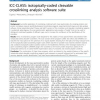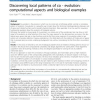BMCBI
2010
13 years 11 months ago
2010
Background: Successful application of crosslinking combined with mass spectrometry for studying proteins and protein complexes requires specifically-designed crosslinking reagents...
BMCBI
2010
13 years 11 months ago
2010
Background: Co-evolution is the process in which two (or more) sets of orthologs exhibit a similar or correlative pattern of evolution. Co-evolution is a powerful way to learn abo...
BMCBI
2010
13 years 11 months ago
2010
Background: A major goal of molecular biology is determining the mechanisms that control the transcription of genes. Motif Enrichment Analysis (MEA) seeks to determine which DNA-b...
BMCBI
2010
13 years 11 months ago
2010
Background: A widely used method to find conserved secondary structure in RNA is to first construct a multiple sequence alignment, and then fold the alignment, optimizing a score ...
BMCBI
2010
13 years 11 months ago
2010
Background: The development of DNA microarrays has facilitated the generation of hundreds of thousands of transcriptomic datasets. The use of a common reference microarray design ...
BMCBI
2010
13 years 11 months ago
2010
Background: Minimotifs are short peptide sequences within one protein, which are recognized by other proteins or molecules. While there are now several minimotif databases, they a...
BMCBI
2010
13 years 11 months ago
2010
Background: Several bioinformatic approaches have previously been used to find novel sites of ADAR mediated A-to-I RNA editing in human. These studies have discovered thousands of...
BMCBI
2010
13 years 11 months ago
2010
Background: Analysis of data from high-throughput experiments depends on the availability of well-structured data that describe the assayed biomolecules. Procedures for obtaining ...
BMCBI
2010
13 years 11 months ago
2010
Background: Ab initio protein structure prediction methods generate numerous structural candidates, which are referred to as decoys. The decoy with the most number of neighbors of...
BMCBI
2010
13 years 11 months ago
2010
Background: Gene/protein recognition and normalization are important preliminary steps for many biological text mining tasks, such as information retrieval, protein-protein intera...


